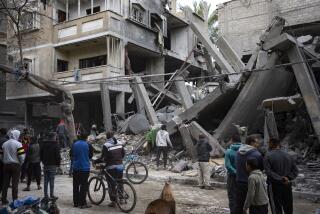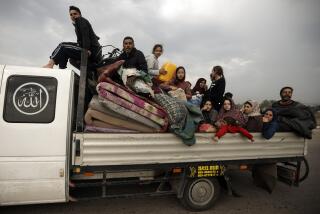Taliban Foes Gain Ground in Tora Bora
- Share via
TORA BORA, Afghanistan — Anti-Taliban fighters advanced more than a mile toward Al Qaeda holdouts Friday as U.S. warplanes hammered this mountainous enclave, the presumed redoubt of Osama bin Laden, with a withering 400 bombs in two days, Defense Secretary Donald H. Rumsfeld said en route to the region.
More U.S. troops joined the fighting, although Rumsfeld said their numbers remain modest. Two Americans reportedly were slightly wounded in the action, but the Pentagon was unable to confirm the injuries.
The search for Bin Laden focused on an especially deep cave in the White Mountains where tribal commanders believe he is holed up. Although some Pentagon officials sought to downplay reports that Bin Laden was cornered or surrounded, others said his proximity is the best explanation for the resistance by fighters of the Al Qaeda terror network in the last few days.
“I won’t speculate, but there are those who believe, because of the intensity of the fighting, that there are things that they are trying to protect in there,” Rumsfeld said during a refueling stop in Shannon, Ireland.
Hazrat Ali, an anti-Taliban commander directing the fighting here, said, “There is one specific cave, and I think Osama is inside.”
“We found it, we see it, and we’re trying to reach it,” said another commander, Said Mohammed Pahalawn. “It’s safe from bombs. Bombs can’t destroy anything there.”
The fighting in the rugged terrain has become the exclusive focus of U.S. airstrikes, including those by ground-strafing AC-130 gunships. U.S. aircraft pummeled the suspected terrorist caves and bunker havens with an intensity unprecedented in the campaign, dropping more than 200 bombs Thursday and 180 in an eight-hour period Friday, Rumsfeld said.
“It’s very heavy, and it’s obviously working,” said Rumsfeld, who plans to visit several European and Central Asian countries involved in the anti-terror coalition. He described the anti-Taliban fighters’ gain of about 1.3 miles Friday as “a heck of a lot in that kind of terrain. . . . They’ve made good progress. They’ve been in a very energetic battle.”
The U.S. continued its airstrikes overnight and this morning on Al Qaeda positions.
Al Qaeda Members Reportedly Captured
Anti-Taliban soldiers reportedly took Al Qaeda prisoners in the fighting. Army Gen. Tommy Franks, the U.S. commander of the campaign, said he didn’t know how many Al Qaeda members had been captured in the Tora Bora area or whether they included top-ranking officials. U.S. forces hope to question them, said Franks, head of the U.S. Central Command.
“It’ll take until tomorrow to get them rounded up, to see who they are,” Franks said at a news conference in Tampa, Fla.
Franks also said that John Walker Lindh, the American Taliban fighter who is being held by U.S. forces in Afghanistan, has been moved from a U.S. Marine encampment in southern Afghanistan to the amphibious assault ship Peleliu in the Arabian Sea.
“He is being treated the same way we would treat an enemy prisoner,” Franks said, meaning that Lindh has necessities such as food and medical care.
Meanwhile, Rumsfeld said Marines are building a makeshift prison at the recently secured airport at Kandahar, the former Taliban stronghold in southern Afghanistan. The secretary said U.S. troops are holding an untold number of detainees who caught their interest after Northern Alliance and other anti-Taliban commanders were finished questioning them.
After two days of hard gun battles near Tora Bora, a pack of Al Qaeda guerrillas was flushed onto a holly-dotted ridge high in the mountains. Trapped there, the fighters were hammered all day and into the night by heavy bombing. Anti-Taliban foot soldiers combed the underbrush, caves and gullies of the charred cave complex in search of fugitives.
As the afternoon siege continued, some Al Qaeda fighters spoke by radio with reporters who stood lower on the slope.
“I want to continue jihad [holy war] up to my death,” one of them said in Arabic. “We have everything, and we’re not sad or afraid of anything. If we die or if we live, either way we win.”
Tribal commanders said they believed that the number of Al Qaeda forces surrounded on the ridge was between 100 and 200. It wasn’t clear how many Al Qaeda fighters remain in the underground caves that pock these hills; Franks said estimates ranged from 300 to 1,000. Tribal commanders have said the battle to drive terrorists from the mountains could take months.
Pacing on the mud roof of a lookout post, radio in hand, commander Ali tried to coax the fighters down from the ridge--with little success. The Al Qaeda negotiator on the other end, who identified himself as Abu Sala Huddin, said he represented 300 people. The group would surrender, he said, but only to the United Nations.
“The United Nations won’t take you,” Ali said. “We are Muslim, we are your brothers, so come down.”
War With Fugitives Grows More Intense
Earlier this week, tribal leaders brokered a brief cease-fire and a series of Al Qaeda surrenders--but in the end, the fugitives backed out of the deals, and the cease-fire crumbled. In its wake, the war took on a new, bloodier intensity.
Tribal leaders have been struggling to rid the mountains south of Jalalabad of the remains of the terror network for weeks. After the fall of the Taliban, as many as 2,000 Arabs, Chechens, Uzbeks and others were hiding out in deep caves carved into these creased mountains. Bin Laden and other top Al Qaeda leaders were suspected of hiding out there with their followers.
At one point in the radio negotiations, Ali appeared to inquire after Bin Laden. “Where is the big guy?” he asked.
“It is not the right time to disclose that,” came the reply.
From the vast, harsh territory they once controlled, Al Qaeda has been squeezed underground and onto a flattened rise of scrubby mountain. The warplanes flew high over the clouds Friday, invisible even when the bombs sparked a quick fire in the treetops, then a great cloud of smoke and a mighty rumble through the canyons. Ali’s troops said a stretch of the besieged ridge was littered with dead and wounded Al Qaeda fighters.
In public, local leaders insist that the U.S. troops here do little more than call in target coordinates for warplanes and sift through evidence from Al Qaeda properties. Privately, however, the commanders say the United States has all but taken over the war.
The foreign troops, including Britons, have been jealously shrouded from public view. But the signs of outsiders are everywhere. The campsites along the mountain trails were littered overnight with empty bottles of mineral water--an unheard-of luxury for Afghan soldiers.
An armed guard at a village schoolhouse said U.S. troops were sleeping inside but added that he’d be killed if any journalists got a glimpse of them.
Officials believe that many of the Al Qaeda fugitives slipped across the border into the remote tribal areas of Pakistan, a region traditionally sympathetic to fundamentalist causes. Pakistan has moved thousands of soldiers to guard the border, but officials admit that there is no way to seal off the rugged frontier.
Rumsfeld will visit several nations participating in the North Atlantic Treaty Organization’s Partnership for Peace program, which links the alliance to nonmember states. He described his trip as an opportunity to capitalize on relationships that have burgeoned since the Sept. 11 terror attacks. Many of the nations have offered varying degrees of assistance in the war in Afghanistan.
Rumsfeld plans to visit Azerbaijan, Armenia and Georgia today before traveling Sunday to Uzbekistan, which shares a border with Afghanistan and is an important ally in the military campaign.
He also planned bilateral meetings in Brussels on Monday and Tuesday with NATO leaders and officials from Russia, Kazakhstan, Kyrgyzstan and Ukraine.
*
Stack reported from Tora Bora and Hendren from Shannon.
More to Read
Sign up for Essential California
The most important California stories and recommendations in your inbox every morning.
You may occasionally receive promotional content from the Los Angeles Times.













